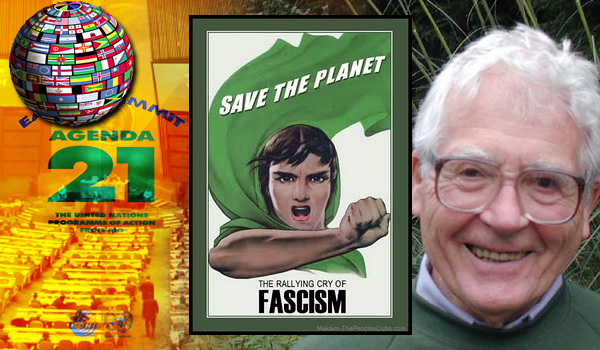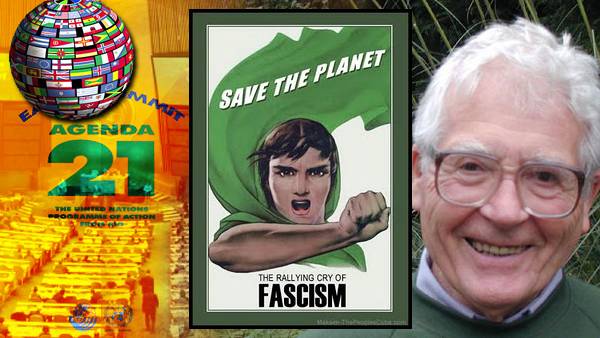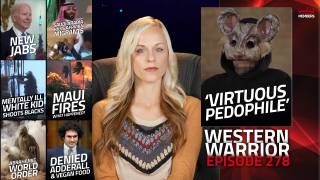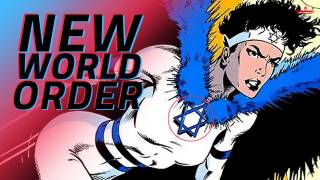The New Gaia World Order
Source: examiner.com

Freedom of choice and basic individual rights are being sacrificed in the interest of the common good, under the United Nations' agenda for the 21st century, called Agenda 21. Under the veil of feel-good terms like "sustainable development" and "social equity", a self-described "new world order" is being systematically implemented around the globe, that is organized around the principle that nature is the most fundamental truth, and which requires all spheres of society to conform to that principle, under the government of a ruling elite (the United Nations and the organizations that support it). When faced with evidence of this unbelievable agenda, the natural question that comes to mind is "Why?"
Two Major Forces
There are really two major engines driving the new world agenda: a quest for control, and fundamental religious belief. What makes this paradigm so dangerous, and effective, is that it merges both forces together under the stated goal of taking care of the environment. The religious background to this environmental agenda is called Gaia, or the worship of the earth. Based on the gaia hypothesis, originally proposed by James Lovelock, this new age religious movement, cosmology, is woven throughout all of the major initiatives, forums, and organizations of the sustainable development agenda. To begin to understand the reasons behind the agenda for a new world order, it is critical to investigate the religious beliefs of the organizations and individuals behind it, and how those convictions undergird an agenda of control.
The new age spiritual movement of Gaia
One of most influential NGOs (Non-governmental organizations) allied closely with the U.N. and intimately involved in their creation of agenda is the Temple of Understanding (TOU), located in The Cathedral of St. John the Divine in New York City. This organization's objectives are, according to its website, "developing an appreciation of religious and cultural diversity, educating for global citizenship and sustainability, expanding public discourse on faith and ecology, and creating just and peaceful communities". Most importantly, although not explicitly stated by the TOU, the cathedral is the center of cosmology, or the worship of Gaia. The Cathedral of St. John the Divine is not only home to the TOU, but has also previously housed the National Religious Partnership for the Environment, the Lindesfarne Association and the Gaia Institute, which are all proponents of the gaia hypothesis.
Among its many globally-influential board of directors members is the Reverend Thomas Berry, the most prominent evangelist for the gaia hypothesis. The Wanderer Forum Quarterly describes the man's religious philosophy: "Thomas Berry, C.P. claims that it is now time for the most significant change that Christian spirituality has yet experienced. This change is part of a much more comprehensive change in human consciousness brought about by the discovery of the evolutionary story of the universe. In speaking about a new cosmology he reminds us that we are the earth come to consciousness and, therefore, we are connected to the whole living community - that is, all people, animals, plants and the living organism of planet earth itself". In Berry's own words, according to The Florida Catholic (February 14, 1992), "We must rethink our ideas about God; we should place less emphasis on Christ as a person and redeemer. We should put the Bible away for 20 years while we radically rethink our religious ideas. What is needed is the change from an exploitative anthropocentrism to a participative biocentrism. This change requires something more than environmentalism." Gaia has become much more than simply a scientific hypothesis. It has transformed into a religious movement which is the driving force behind global social change.
To help illuminate the beliefs of Gaia, as propogated by the TOU and many U.N. leaders and organizations behind the new world order agenda, it is helpful to review a U.N. report called Shared Vision, from the 1988 Global Forum of Spiritual and Parliamentary Leaders for Human Survival, which was founded by the Temple of Understanding. In summarizing the speech given at the conference by James Lovelock, founder of the Gaia hypothesis and author of Ages of Gaia, the report details, "...Lovelock's contribution is to suggest that life on earth regulates its environment as if it were one huge organism. The name given to the organism - and the idea - is that of Gaia, the Greek earth goddess." According to the report, Lovelock said, "She is of this Universe and, conceivably, a part of God. On Earth she is the source of life everlasting and is alive now; she gave birth to humankind and we are a part of her." The report indicates that Lovelock..."...likened the current global warming to the first signs of a fever, but is worried that we are not allowing Gaia to recuperate". In other words, Earth, as one huge organism, is seen as one with God. By doing damage to the Earth, humans are, according to this belief, damaging God. It is this spiritual conviction which provides the rabid determination behind the environmental movement, and the objectives of sustainable development.
Global Forum: Where religion of nature meets the politics of control
The 1988 Global Forum of Spiritual and Parliamentary Leaders for Human Survival began the marriage between religion and environmental objectives on a worldwide scale. From this conference, many additional forums around the world were organized to bring together world leaders in government, environment, religion, and science for the purpose of collaborating around the goals of sustainable development. The National Religious Partnership for the Environment (NRPE), created in 1993, came out of these global meetings. The NRPE developed a plan for "integrating issues of social justice and the environment" which included education and action kits to religious congregations around the world, training programs for religious students and leaders, and a variety of other worldwide actions specifically targeted to ensure that religious groups adopted the goals of this globalist environmental agenda. Worldwide religion, the objectives of sustainable development, and the Gaia movement all became wedded together into a tapestry which could only be woven effectively through broad-scale, worldwide control.
Religion of nature meets politics: Robert Muller
Dr. Robert Muller, former Assistant Secretary General to the U.N. and member of the Board of Advisors to the Temple of Understanding (which founded the Global Forum), gives evidence to the marriage of Gaia with the movement of sustainable development in his paper A Cosmological Vision of the Future from 1989: "Now we're learning that perhaps this planet has not been created for humans, but that humans have been created for the planet...We are living Earth. Each of us is a cell, a perceptive nervous unit of the Earth. The living consciousness of the Earth is beginning to operate through us...We have now a world brain which determines what can be dangerous or mortal for the planet: the United Nations and its agencies, and innumberable (sic) groups and networks around the world, are part of the brain. This is our newly discovered meaning...we are a global family living in a global home. We are in the process of becoming a global civilization...The third millennium should be a spiritual millennium, a millennium which will see the integration and harmony of humanity with creation, with nature, with the planet, with the cosmos and with eternity." This key U.N. leader, in charge of creating policy on a worldwide scale, shows how cosmological faith drives an agenda for a global community, in the interest of protecting the god of nature. When the scope of this religious conviction becomes clear, it is easy to understand how it leads to an agenda of globalized control, in order to align the actions of human society toward elevating the goals of taking care of Gaia above all else, including the people who are a part of her.
Muller won the UNESCO Prize 1989 for Peace Education for his World Core Curriculum, an educational initiative to make students into global citizens who take care of the planet. According to Muller's website, robertmuller.org, Muller says, "The entire humanity must be reprogrammed through a right global inducation (Latin ex-ducare, to lead out, in-ducare, to lead into)". Just what is this U.N.-endorsed global education, as created by this proponent of Gaia? Muller explained the reasons behind his World Core Curriculum in a 1995 speech to the College of Law at the University of Denver: "I've come to the conclusion that the only correct education that I have received in my life was from the United Nations. We should replace the word politics by planetics. We need planetary management, planetary caretakers. We need global sciences. We need a science of a global psychology, a global sociology, a global anthropology. Then I made my proposal for a World Core Curriculum." The first principle of the curriculum is: “Assisting the child in becoming an integrated individual who can deal with personal experience while seeing himself as a part of 'the greater whole.' In other words, promote growth of the group idea, so that group good, group understanding, group interrelations and group goodwill replace all limited, self-centered objectives, leading to group consciousness." Muller's influential philosophy is the perfect example of how nature-centered spirituality and an agenda of worldwide control go hand in hand with the United Nations and its supporting organizations.
Religion of nature meets politics: Maurice Strong
This religious conviction and political agenda of control is shared by, according to many accounts, the most powerful man in the world. Maurice Strong was Secretary General of the U.N.'s Rio Earth Summit in 1992 (where Agenda 21 was adopted), and former Executive Director of United Nations Environment Programme (UNEP). According to Henry Lamb, one of the most researched writers that exists on the issues of globalism, "He, perhaps more than any other single person, is responsible for the development of a global agenda now being implemented throughout the world." Strong, a billionaire and a brilliant, phenomenally influential U.N. bureaucrat, is a devotee of earth-bound spirituality aligned with the Gaia movement. To help illuminate the scope of his influence, consider that he has served in a multitude of key international positions, including Director of the World Economic Forum Foundation, Chairman of the Earth Council, Chairman of the Stockholm Environment Institute, Senior Advisor to the President of the World Bank, Chairman of the World Resources Institute, and, most interestingly, Finance Director at the Temple of Understanding. Strong and his wife, Hanne, created the Manitou Foundation in 1988 "to provide land and financial support to qualified spiritual organizations, earth stewardship programs, and related educational opportunities for youth and adults" according to the Crestone Institute. Their 200,000 acre ranch near Crestone, Colorado, known as Baca Grande, is now a new age spiritual center run by Strong's wife.
Strong co-founded the Earth Charter Commission with Mikhail Gorbachev in 1997. This document, which has been endorsed by the U.N., reveals the spiritual nature of the agenda for sustainable development. In its preamble, the Earth Charter states, "We must join together to bring forth a sustainable global society founded on respect for nature, universal human rights, economic justice, and a culture of peace...The protection of Earth's vitality, diversity, and beauty is a sacred trust". After addressing the fact that "the benefits of development are not shared equitably..." (the communistic principle of redistribution of wealth from the haves to the have-nots), the preamble goes on to express: "The emergence of a global civil society is creating new opportunities to build a democratic and humane world. Our environmental, economic, political, social, and spiritual challenges are interconnected, and together we can forge inclusive solutions...The spirit of human solidarity and kinship with all life is strengthened when we live with reverence for the mystery of being, gratitude for the gift of life, and humility regarding the human place in nature". Strong's comments in his opening address at the Rio Earth Summit summarize his philosophy clearly: "It is the responsibility of each human being today to choose between the force of darkness and the force of light... We must therefore transform our attitudes, and adopt a renewed respect for the superior laws of divine nature." This is not simply an idealistic agenda, but a deeply rooted spiritual belief about nature as god. And it is an agenda, driven by religious conviction, and intricately interconnected with a plan for a tightly controlled global society, that is being propagated by the most influential individuals and organizations on the planet.
The modern face of Gaia and the environment: Al Gore
Former Vice President Al Gore is a devotee of Gaia, and the modern face of the environmental movement. Gore has been involved with the Temple of Understanding, including giving a sermon at its annual celebration of St. Francis, a ceremony whose Blessing of the Animals included blessings for an elephant, algae, and a bowl of worms and compost. According to a 1994 publication by the Cathedral at St. John the Divine, at this sermon Gore asserted, "God is not separate from the earth". Gore's famous book, Earth in the Balance, has three chapters devoted to the "Earth Goddess", and on page 259 he writes, ""This we know: the Earth does not belong to man, man belongs to the Earth. All things are connected like the blood that unites us all." The theme repeats itself: a pantheistic, new age belief that the earth is god, and humanity is here to protect her above all else.
Read the authors personal conclusion and opinion at the source examiner.com






















